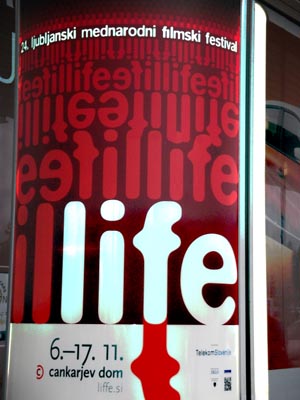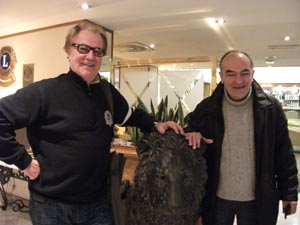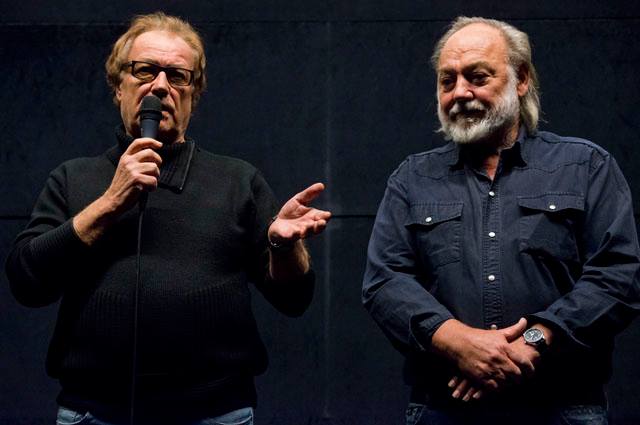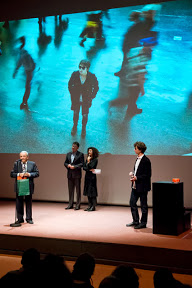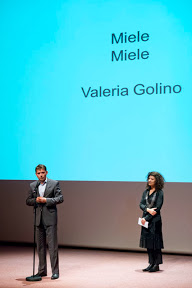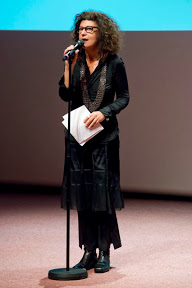|
|
||
|
Pro Tools
FILMFESTIVALS | 24/7 world wide coverageWelcome ! Enjoy the best of both worlds: Film & Festival News, exploring the best of the film festivals community. Launched in 1995, relentlessly connecting films to festivals, documenting and promoting festivals worldwide. Working on an upgrade soon. For collaboration, editorial contributions, or publicity, please send us an email here. User login |
Tribute To Jacques Tati at Belgrade’s Author Film FestivalBelgrade’s Author Film Festival hosted Dominique Abel and Fiona Gordon and gave a couple of screenings of The Fairy (La Fee) to a festival audience, including the screening of their previous film Rumba. The actually amazing Belgian based filmmaking trio Dominique Abel, Fiona Gordon and Bruno Romy are back with their second (actually third) old school approach film The Fairy (La Fee). Even if the film is firmly grounded in dedication to the artwork of Keaton or Charlie Chaplin, authors here give the special tribute to a great Jacques Tati, for which I would like to congratulate on originality: no one ever thought to bring the old film school and physical theatre in joint combination back to a big screen! These authors are the first filmmakers who today are making films directly connecting theatre and old school art house film: actually experimenting on film: “…Cinema gives us the possibility to create something that leaves a trace. Our cinema is very much influenced by our stage experience. Our style and methods are probably similar to the silent film pioneers who came for the most part from theater as well,” said Dominique Abel. In addition, within any further art house exposure to colorful sight gags, this truly original team applies to an old school approach with light-hearted comic gag scenes. Their easy brightful episodes are a wonderful agenda to take you back to a silent film era and could justifiably function as a silent film as well. “We are influenced by the silent film stars but also by live performers who amazed us when we saw them in Paris; the Czech Clown Bolek Polivka, the Argentinean clown Carlos Traffic, Ariane Mnouchkine, Peter Brook. The influences from the film world are many: Fellini, Powell and Pressburger, Capra, Kaurismaki, Peter Sellers, Monty Python, Woody Allen's early films, Pierre Etaix, Kurosawa's early films, Jacques Tati's early films, Meliès, Slobodan Sijan..." said Fionna and Dominique. Sijan is Serbian filmmaker. But Tati’s, according to Dominique Abel, evident here in the precise art direction and camera cadre. The dialogue of film is brilliant, cleverly used with music, (a jazz standard What a Difference a Day Makes performed by Nina Simone), where music used, play a crucial role to a performed acrobatic, skilful and basically very theatrical role, engaging graceful dance sequences or better say physical theatre sequences on film. Sequences here serve as brief intermissions to the actual extraordinary for film, physical or rather dance performance action. Moreover, in order to celebrate Jacque Tati I quote a little something about Tati… "no celebration, no artistic or acrobatic spectacle can do without this amazing performer, who has invented something quite his own…His act is partly ballet and partly sport, partly satire and partly charade. He has suggestive powers of all great artists. Tati’s success says a lot about the sophistication of the allegedly “uncouth” public, about its taste for novelty and its appreciation of style. Jacques Tati, the horse and rider conjured, will show all of Paris the living image of that legendary creature, the centaur…”
But, let us go back to our guests of honor, the festival guests Dominique Abel and Fiona Gordon. The Fairy (La Fee) directed by Belgium-based trio Dominique Abel, Fiona Gordon and Bruno Romy did made a great impact on largely film oriented festival audience and this is something worth telling, and it is a kind of proof of appreciation to a glorious beginning of film and theatre groundwork. They are specializing in circus-clownlike theatrical mime and physical theatre and, have found the kind of humour in the everyday actions taken by the characters. The bicycle chains, bottles in the kitchen, sandwich, and telephone in the hotel room or chairs become instruments of the hilarious inspiration, just like in the old-fashioned physical comedy that has faded from cinema long time ago.
This is contradictor, semi-absurdist and so innocently honest comedy and in order to explain what I need to say I have to tell you the plot. Dom is a receptionist in small hotel at night. One night Dom, a dedicated and self-respectful French character, decides to spend his evening in front of the television, accompanied with his sandwich. But just when he was about to take a bite while his television broadcasts Simone’s standard What a Difference a Day Makes, people starts to check in. First an American tourist with dog and then Fionna, strange woman who claims to be fairy: barefoot with no hoofs on (by Serbian mythology fairy is an evil devil creature with hoofs instead of feet). I would like to go through details that brings to mind a theatre based Tati on film. There is classic Tati right there at the beginning of the show: it is a well known useful repetition of the situation, cause every time when Dom wants to take a bite and great song from television starts, someone shows up to interrupt him, so he puts down his sandwich and shuts down the television all over again. Also there is Tati and clown experience presented in the entry scene: when Dom rides too small bicycle too fast and Tati gag is when bicycle begins to break down and clowny Dom, too big for his bike, keeps on to ride too fast.
Anyway, when Fiona signs in, she tells Dom that she is a fairy and wants to grant him three wishes. Therefore, he wishes for a scooter and free fuel for scooter but cannot remember third wish. In the morning, he finds the scooter waiting and meets Fionna at the café. Later on Fionna shows him entire storage tank of petrol spigot. Since there are no fairies and no free petrol supply in the real world, Fionna ends up in the local psychiatric ward. Nevertheless, to prove her divine origin and their love Fionna becomes pregnant overnight and gives birth to a boy Jimmy. In addition, there is a comic gag coming up here. Their baby Jimmy stays on the hood of running car, while two of them are trying to get him running after the car. There is a lot of running in the film, and yet another classic Tati gag is when they are running away from the psychiatric ward nurses and the police with their baby and entire colon of people are behind running after them.
There is also a particular part I like due to a cynical digression for contemporary living that sneaks about in this film full of classical old style movie gags: Fiona likes to play with other psychiatric ward residents marble card poker lets-throw the-dice game with their medicines behind nurses back, and they all greatly fond of bright colored pills they put to stake instead of money! Hilarious! And yes we laughed and laughed… According to Dom and Fionna, they are embracing an exploration in their scripts and it looks as they improvise right there on the spot, while they creativity invent endless ways to use their bodies in order to twist the situation. Whenever there is narrative romance moment, there is always a good chance for a spontaneous physical or theatrical moment with dance scene. They have established the ideal format for a new brand of comic book humour done on film, creating beautiful poetic settings to clown (play) around with. Interview with Dominique Abel and Fiona Gordon
R: You have made great success with your previous film Rumba, is there any difference now with this film The Fairy? Dom: The first two features that we did were done more in the countryside. This time we wanted to do film in city, to gain urban atmosphere more then in the previous films. We have found the port, harbour in France and we put our character in hotel. We wanted to talk about fragile side of human being, bit lost in town, bit too tiny, where everything is too big for him.
R: You mentioned on the press conference story about the big wide world and story about the performance of the clown: your characters are doing physical theatre, tell us about your unusual style.Dom: Our film is a visual cinema and it suits well because it is still popular, also, it is an author work. It is funny, and is a vision of three persons and their life in a big wide world. I think it has frontier easily because there is not a lot of words in. After all, we do not decide how many people are going to see our film, but we would prefer lot of people to see. In a way, it is a bit like when you do restaurant with local food and you get what you want with things that you do and you like to do it well. And you know that what you do, do not please majority. We will do what we like and after all, we decide all no matter.
R: Your film has different kind of editing tell us about the process of making?
Fionna: We are not doing our show in front of the camera. The show is not done in front of the audience, but it cannot be imagined without the audience. We picture audience in mind, and then we create our film. We imagine audience. The audience is completely independent partner. We want to use theatrical experience to make film, but we do not do theatre show, we are making a film. It is not the same architecture. When we have the stage, the audience cannot see everything at once, they have to look over there or look over here to focus. And they do not do everything at the same time. But with film, on the contrary, audience have to contact the big screen and see everything at once. And on this way, this is very different.
Dom: We think that if we would do a theatre show out of our film, we would have to change it a lot. Also, we would never film one of our theatre shows to make a good film. It wouldn’t work. Even if we are, in both cases, inspired by the movement, by physical and the physical comedy as the rule on the stage, in the circus, or in the street performance. Theatre existed before and camera was invented after. It is two different media, it is bit as if it would be mixing sculpture and the theatre and we like both. It is not the same tool.
Fiona: When you do theatre, you have to be in a completely neutral space and you make audience believe that they are somewhere else and give them information. There are lot of theatre convention where you can make anyone believe that they are anywhere else but where they actually are. With cinema, you can do that. You have to use other visual tools to make someone believe.
Dom: But when we do our cinema, we look for that kind of complicity, which are based on imagination. We like to laugh together with the audience, about the same way we build our story. And the way we do our special effects. We know that others know that is fake what we do, and that it is a part of joke, we use effects of old tricks of cinema. We like to use it because humanity is in the medium. We can see people and the techniques. And we do not want to use technique for the technique. We have to relay on the body to give the reaction, and if the technician want to do it, the technician will do it.
R: Can you comment the connection of your cinema to Jacques Tati’s?
Dom: Tati in fact is coming from the stage. He was performing on the stage in theatre for 15 years and then he went in front of the camera. His family has a long tradition of performing in theatre, just like Baster Keaton and Charlie Chaplin and when the cinema was not silent any more this kind of film fade out. But every once in while you have someone doing it, not out of nostalgia, but because he or she likes it. Tati first worked a lot on the sound movie. But when we do what we do, people often speak about Tati because there are not a lot of other references out there, not lot of others. He was the first who have had access to colour and the sound in film. You could also say Pierre Etaix; you could mention perhaps Peter Sellers, with film like The Party: it is a very physical comedy and nowadays there are other people not well known. For instance, someone like Bent Hamer, Bent is a Norwegian film director, also Roy Anderson actually quite a lot of people. It is not often in cinema to see people working on the non-naturalistic way. When you look at the other art, like theatre or performance in the street, then you see that you have lot of people inside. And lots of imagination, lots of try out. Many left cinema because it is too expensive.
Fiona: Now why I understand why you have strong association with theatre. It is usually in cinema people use only one side of naturalism. For instance, if you think about naturalistic paintings, you know that not all painters are naturalist. In cinema, it should be the same way. Somehow, naturalism is the dominant current. Perhaps it is only thing you could do before photography. Perfectly naturalistic!
Dom: Even if the naturalism is not something you can relay on, it could be very emotional, it is very psychological. We are not like that in real life. You could see the concentration of psychology in our films: it is incredible. They (our characters) have emotions: they crack up, they get mad…It is not natural, but has a dominant style. For instance, if I wanted to speak to you in close up I would be 2cm away from you, so you have that image. It is not natural but it is usual. Same in cinema.
20.12.2011 | Radmila Djurica's blog Cat. : Ariane Mnouchkine Author Belgrade Belgrade Author Film Festival Red Carpet Bent Hamer Bruno Romy Carlos Traffic Comedy film DOM Dominique Abel Employment Relation Entertainment Entertainment Film film director Fiona Gordon Fionna food France In cinema Jacque Tati Jacques Tati Jacques Tati Jimmy Mime artist Mimes Monty Python Musical theatre Nina Simone Our Cinema Paris Person Career Person Location Peter Brook Pierre Etaix Powell and Pressburger Quotation receptionist Roy Anderson Rurikids Slobodan Šijan Sound film technician The Party Theatre With cinema Woody Allen Independent
|
LinksThe Bulletin Board > The Bulletin Board Blog Following News Interview with IFTA Chairman (AFM)
Interview with Cannes Marche du Film Director
Filmfestivals.com dailies live coverage from > Live from India
Useful links for the indies: > Big files transfer
+ SUBSCRIBE to the weekly Newsletter Deals+ Special offers and discounts from filmfestivals.com Selected fun offers
> Bonus Casino
User imagesAbout Radmila DjuricaThe EditorUser contributions |



















